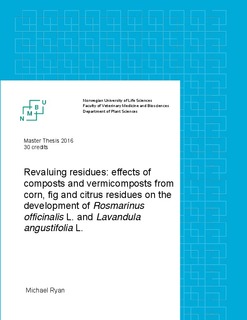| dc.description.abstract | Intensive agricultural production generates large quantities of organic waste and residue worldwide. Health and environmental hazards can result with the improper disposal and accumulation of these materials.
Composting and vermicomposting can be used to recycle crop residues, manures, and wastes as soil amendments and biofertilizers, thereby reducing the overall amount of waste and residue in the agroecosystem.
In this study, separate composts and vermicomposts were prepared from three crop residues (citrus, maize, fig) and precomposted rabbit manure. Cuttings of rosemary and lavender were grown in the prepared substrates for 4 months. Initial and final substrates were characterized chemically and growth characteristics of the plants were measured.
Vermicomposting resulted in significant reduction in carbon-to-nitrogen ratio (C/N) and an increase in total N (TN) compared to composting. Composts resulted in higher electric conductivity (EC) values than vermicomposts, implying that they may be more useful as soil amendments. Vermicomposted substrates had lower shoot/root ratio than composted substrates and could be due to the greater amount of humic compounds that promoted root development. Vermicomposts had significantly higher cation exchange capacity (CEC) values, which was found to be positively correlated to all plant growth traits, with the exception of branch number for rosemary plants. CEC was used as the main determining factor, which in conjunction with nutrient content helped explain the superior performance of vermicomposting over composting. It was concluded that vermicomposted citrus residues (VC) proved to be the superior substrate for both rosemary and lavender plants, as development traits were greater than both maize and fig residues for both species. | nb_NO |
